MonoPulse realism
- start with an Oxford Dictionary definition.
Fidelity, the degree to which the output of a system reproduces the characteristics of the input
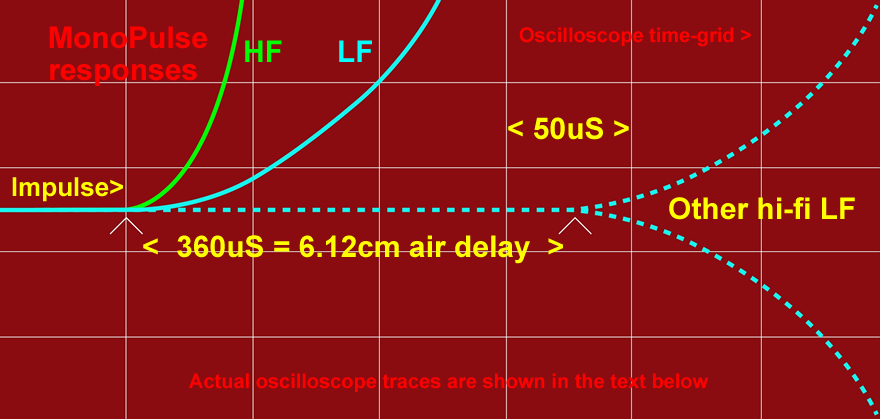
Our ancestors had to sense danger - like a breaking twig in the dark.
 Allan Hendry, the MonoPulse creator, built his first radio at ten. This was followed by various amplifiers, tape recorders - and loudspeakers.
Allan Hendry, the MonoPulse creator, built his first radio at ten. This was followed by various amplifiers, tape recorders - and loudspeakers.
School A levels were physics & maths, and at weekends he repaired radios & TVs for a local shop. Doing a degree in Electrical Engineering at Kings London, he kept his interest in loudspeaker design. A particular issue was puzzling him.
His career was technical - and international, much in the USA - infra‑red detection, cryptography, environmental testing, secure communications, radio for GCHQ, flight data recorders, radio relay in 120 countries, and US government security.
But Allan didn't stop thinking there was a problem with loudspeakers.
Retiring as a main board director of a FTSE100 company, and a Fellow of the Royal Aeronautical Society, Allan finally got the chance to tackle that loudspeaker puzzle.
So what was the problem?
In the dark, we have an amazing ability to sense the direction of a sound - and danger. Our lives depended on this. And the ability remains. Blindfold someone, spin them round, break a twig. The listener will point to the source, within about ten degrees.
But if you make a continuous tone - he will have no idea where the source is.
And that was Allan’s problem.
Nearly all loudspeaker theories, designs and testing, seemed to be based only on how they reproduced those continuous tones.
So how do we detect the direction of that breaking twig? That sound contains impulses. Our two ears will receive those impulses at slightly different moments. This is the timing that our brains detect. And to get that awareness of ten degrees, we detect the timing difference it takes sound to travel about 3 millimetres.
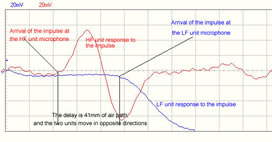
A typical two-way speaker design, has an HF unit mounted above a larger LF unit. The origin of sound is the voice-coil at the back. An input will trigger both the HF and the LF voice coils at approximately the same time.
But the HF unit is much smaller, so its voice-coil is well in front of the voice-coil at the back of the larger LF unit. The first air pulse from the HF unit will be on its way, well ahead of the one from the back of the larger LF unit.
And it shows in actual measurements. To the right - is a top quality speaker's response to
a single impulse input. The output becomes two impulses (in red and blue), traveling more than four centimetres apart. Worse, multiple tests show that they are usually out of phase (as here) The first pressure wave from the HF unit is positive, the one from the LF unit negative. For larger diagrams see Parts 1 & 2 below.
Importantly for hi-fi realism, this is nothing like the all-important three millimetre impulse accuracy, with its realism, directional accuracy and sound stage. Allan came to realise that conventional multi-way designs do not even set out to achieve impulse precision. (Also that true impulse integrity is impossible with more than two drivers)
The MonoPulse solution.
From his involvement with radar, Allan registered the brand name MonoPulse, (a type of radar working on the same principles) This was for a yet to be designed, impulse-accurate, hi-fi loudspeaker.
It looked easy – move the speaker positioning – take the HF unit back so the two voice-coils were the same distance from the front of the cabinet. But of course there was still the need to get the continuous-waves to give an even in-phase response at the crossover.
It needed completely new crossover designs, combined with only two drivers selected for exactly the right characteristics. These had to be placed to the millimetre. The result is acoustic accuracy, true-to-life, with all the original integrity. Music is full of impulses, and their synchronous timing gives our enjoyment of reality, presence and sound-stage.
(Impulse accuracy is completely impossible with more than two drivers)
Can the MonoPulse difference be measured in laboratory tests?
Yes, and very clearly. This, and its significance, are shown and explained below in three parts. Read on.
The Quest for Realism. Part 1 - The Impulse Measurements.
To measure a speaker's response to an impulse or leading edge, needs an input step function to the loudspeaker:
Impulse input.
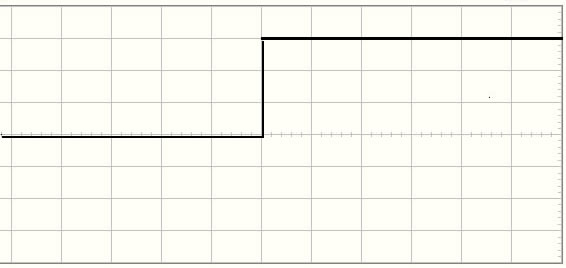
^
^
^
^
^
^
^
Volts.
Time >>>>>>>>>>>>>>
The resulting responses of the two drive-units are then measured. Below is the response of the MonoPulse Model A.
The HF unit is shown in blue, and the LF unit in red. We want the onset of the two traces to be in exact synchronism - the simultaneous start of an impulse response.
MonoPulse Model A impulse response.
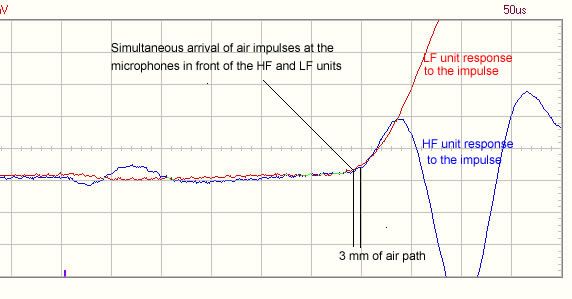
As you can see, the onset of the responses occur at the same moment - meaning that the high and low frequency components in the impulse will arrive at the listener together. They are also in the same direction - you might have assumed this - but read on.
(The rapid bounce-back of the HF unit is normal, and will be seen on all traces. HF units respond only to high frequencies and their cones or diaphragms move back quickly once the leading edge of an impulse has passed.)
The divisions show the time sound takes to travel 17 millimetres. MonoPulse designs achieve 3mm accuracy of air path.
Do we need this accuracy? Yes. We can sense the direction of a sound, such as the snap of a twig, to about 10 degrees.To do that, we detect the different impulse arrivals at each of our ears. And to get that 10 degrees of accuracy, we need to detect impulse arrivals to that 3 millimetres of air path. (More about the significance of the twig in part 3)
So what are the actual responses of other top-end loudspeakers?
Typical impulse response of a prestigious two-way hi-fi loudspeaker.
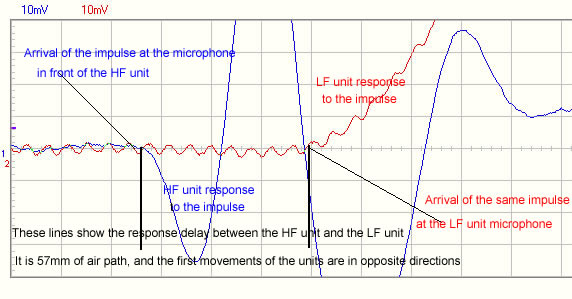
(The "wiggle" on the LF trace is electrical noise where these measurements were taken.)
In these measurements of a top of the range prestigious speaker, two points are immediately obvious: The first, unexpected, is that the initial movements of the HF unit (blue) and the LF unit (red) are actually in opposite directions - the HF unit starts by moving in, the LF unit starts by moving out. The drive units are out of phase. (Amazingly, this is usually deliberate - see more in part 2 below)
The second, as expected, is that the response of the LF unit lags behind the HF unit - by nearly 60 millimetres of air path. So what should have been a single impulse, has become two separate impulses traveling towards the listener - 6 centimetres apart, and out of phase.
It is difficult to belive this is glossily presented as top end hi-hi.
It is certianly not within that dictionary definition of "fi+del+it.y" - and is why the MonoPulse was created.
In reality, no conventional multi-way design seriously sets out to achieve impulse precision. The design mathematics merely get continuous-waves in synchronism, and a smooth frequency response at the crossover frequency(s). The reason the MonoPulse design took so long is that it sets out to combine this with impulse accuracy.
Allan Hendry commented, "From the physics I knew, there had to be an issue with the conventional multi-way. But, until I'd proven the MonoPulse idea, I didn't bother measuring other speakers. No point. But when I did, that timing error amazed me, as did the out-of-phase movement. So, perhaps these things are best left unmeasured - as they conveniently are?"
Below is the trace from a particularly expensive model. Again it shows the units setting off in anti-phase, and with the LF unit lagging the HF unit, this time by about 4 centimetres of air path - better - but well away from the needed 3mm.
These are randomly selected top-of-the-market, units, and more expensive than the equivalent MonoPulse models.
It is mentioned in Keith Howard’s article for Hi-Fi News, (part 2 below) that some hi-fi loudspeaker manufacturers have now, like MonoPulse, adopted in-phase driver connection. This change is confirmed by one of our measurement (below), showing that the initial movements of the two units are in the same direction.
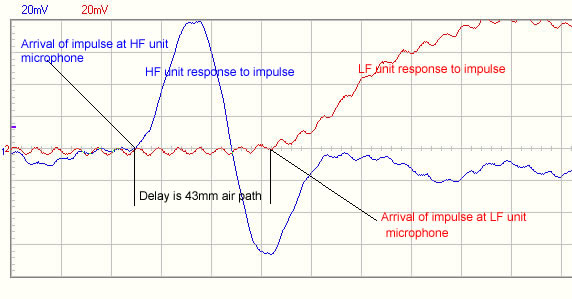
But, unfortunately, the LF unit (red) still lags by 4cm of air path. The activity in the HF unit is all but over before the LF unit responds to the same input. This is despite the fact that the HF unit is separately mounted on top, and allegedly "time aligned".
The situation becomes even worse with three-way designs. These have the same timing discrepancy between their HF and MF units. Then there is a further delay of the LF unit behind the MF unit, typically up to 200 millimetres of air path, and in the wrong direction.
It ends up with two of the three units initially going in one direction, and the other the opposite way, and with large timing errors. This was true for all the makes of three-way units we tried - and even worse for those with more than three drivers.
Shouldn’t the crucial loudspeaker link in the hi-fi chain be faithful to real-life?
Read on to Part 2, Keith Howard's Hi-Fi News article, and Part 3, Our hearing and MonoPulse, both below. Or return to the top
The Quest for Realism. Part 2 - Phase Change – quoted from Hi-Fi News.

"Your speakerís drive units may be connected out of phase. It isnít faulty – it was designed that way. But, asks Keith Howard, our technical consultant, is this really a good idea?
If you are familiar with the design of loudspeaker crossovers, you will know it is common practice to internally connect up drive units with opposite polarities.
Average hi-fi users, with the familiar warning about connecting speakers to the amplifier with consistent phase (red terminal to red terminal, black to black) ringing in their ears, will find this odd. There are good reasons why itís done, but it turns out that the knee-jerk reaction to consider it strange may be the right one.
Some loudspeaker designers have come to the conclusion that it is a bad habit the audio industry should break.
Talking to a succession of speaker designers in recent months, they have mentioned a factor which isnít often heard about – loudspeaker impulse response - and the impulse response of a typical multi-way loudspeaker is not a pretty sight.
MonoPulse speakers have been designed with impulse response firmly at the top of the agenda.
Allan Hendry justifies his unusual choice of crossover filters on the basis that it allows the bass-mid unit and the tweeter to be connected in phase.
And I had a telephone conversation with Steve Roe of B&W whose latest 800 Series deliberately avoids anti-phase driver connection. And why? For the best possible reason: it sounds better.
The article then explains why anti-phase driver connection has been used for decades in hi-fi loudspeakers, since Siegfried Linkwitz and Russ Riley in 1976, and their second-order crossover design. The article also includes the comment...
But if you look back through audioís annals you will find occasional voices raised in unease at it. Over 20 years ago, Richard Greiner. To paraphrase what Greiner was saying, is that if you put an impulse into a speaker with opposed driver polarities, then as one diaphragm moves forward, the other will move back – an intuitively undesirable situation, particularly given the established significance of leading-edge transients in music."
Read below, of the way we hear sounds, and why the MonoPulse design is so significant.
Or return to the top
The Quest for Realism. Part 3 - Our Hearing and the MonoPulse Design.
This section explains why time-domain impulse accuracy is key to our perception of direction and realism.
It needs some facts about our hearing, and about why hi-fi loudspeakers have problems in handling sounds in a way which reproduces real life.
So let’s start from the beginning...
It’s in our evolution.
Our ancestors had to sense danger, such as from the sound of a breaking twig, to survive in the world in which we evolved. We still have this ability to know where a sharp-edged noise came from. But how we do this is not at first obvious.
How do we hear anyway?
Any continuous sound, however complex and harsh, is in fact a mixture of many pure tones – as proven many years ago by the mathematician Fourier. In each of our ears these sounds are detected by about 3,000 tiny sensors, each 'tuned to', or picking up a resonance at, a different frequency. When we listen to a noise just those sensors for its particular mix of pure tones will react – and each one sends a signal to the brain. Our brains analyse and recognise these different combinations of frequencies – maybe as the shriek of the wind, the howl of a wolf – or the cry of a child.
So our brains know which sensors are reacting
And interpret this tone mix as a particular sound. But, once the sound has started, these sensors have no sense of phase - in which direction the incoming air pressure is moving at any moment - just that it is moving. So, if we are not sensitive to phase in sound waves – that it means sound-systems which mess it up are OK? No.
It’s not quite so simple - or convenient.
The problem is revealed when you consider how we so accurately sense a sound’s direction. We do not sense direction from continuous tones. An example is that it is not always easy to tell exactly where a smoke detector alarm sound is coming from.
We sense direction by using the sharp-edged impulses at the leading edges of sounds. One bit of phase our brains can detect, very precisely, is the exact moment that a leading-edge pulse arrives. Depending on the direction they came from, these pulses arrive at each of our ears at different moments. And, by sensing the difference in those arrival times, we work out the direction.
To position the source of a sound to within ten degrees, needs an accuracy of about 3 millimetres in air-path detection. A bit of simple geometry can show this.
Why is this an issue for hi-fi realism?
If we close our eyes in front of a group or orchestra, we don't just know what instruments are playing, we also have a sense of space and position. This is the sound stage. This is what we want a hi-fi system to reproduce. Without it there is no proper sense of realism.
The impulses produced by that orchestra start at one moment in time from their different sources and arrive, unchanged apart from volume, at our ears as a single wave-front. There is impulse integrity - all frequencies within that sound travelling and arriving together.
So, what happens with typical multi-way hi-fi loudspeakers?
An impulse, like any component of sound, is a mixture of frequencies. In most loudspeakers these are split up by crossovers, or by digital processors, and sent to different drive-units, with acoustic-centres at different distances from the listener. These differences are typically more than 4 centimetres different. The result? What should be a single clean wave-front, has divided frequency components arriving at our ears at different times. This was shown by the measurements in part 1 above. So our brains, which sense so much from the arrival timing of a real-life impulse, know that we are not in a natural sound-stage.
And it gets worse
An erudite article in Hi-Fi News in July 2005, "Phase change", by their technical editor Keith Howard (extracts in part 2 above), revealed that nearly every multi-way hi-fi design in the last forty years, presented with an impulse, has one speaker cone with its initial movement in one direction, and the other(s) going in the opposite direction. What does our highly evolved auditory system make of that? Conclude that this is not a sound made by a real event? Almost certainly.
Keith Howard himself comments, "it is a bad habit the audio industry should break."
So what does MonoPulse do?
The MonoPulse holy grail is impulse integrity. We use only two high-quality drive units, closely spaced, correctly offset to millimetre accuracy, and with special crossover electronics, to give a single impulse wave-front, accurate to within the 3mm detectable by our ears.
MonoPulse hi-fi loudspeakers can improve any system. The impulse accuracy means that they can create a sound stage even if placed wide apart. It can be a dramatic effect - and shows that if positioned conventionally, the sound stage will be superior. Everything is better – but unplugged style recordings are the most changed. In a musical sense, the human voice is the instrument we are most familiar with – and full of sharp-edged impulses from our imperfect vocal cords. We can tell if that sound has been messed around – or notice the difference if it has not.
Try it!!
Allan Hendry, BScEng, AKC, FRAeS
Return to the top Or
Return to Home

 Allan Hendry, the MonoPulse creator, built his first radio at ten. This was followed by various amplifiers, tape recorders - and loudspeakers.
Allan Hendry, the MonoPulse creator, built his first radio at ten. This was followed by various amplifiers, tape recorders - and loudspeakers.




